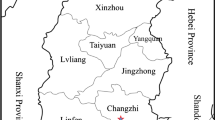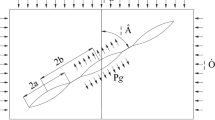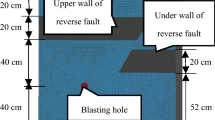Abstract
A series of experiments of soft coal under different explosive dosages were carried out in this paper. The crack morphology and deformation characteristics of coal were analysed and the regional response characteristics of the internal resistivity of coal obtained. The results indicated that under blast loading, the soft coal presented three types of blasting-induced cracks: radial main crack, circumferential main crack and radial microcrack. The movement deformation of coal led to the change in coal density in different regions. The coal density around the circumferential main crack and the radial microcrack generally decreased, while the coal density around the radial main crack generally increased. The electrical resistivity tomography analysis of soft coal after blasting showed that resistivity increasing and decreasing zones were evident. Coal resistivity under the squeezing of explosion gas decreased, whereas the coal resistivity affected only by explosion stress wave increased. With the increase in explosive dosage, the area of the blasting-induced crack and the volume of blasting cavity both increased first and then decreased. However, under the same explosive dosage, compared with the experiment with the sealing blast hole, the blasting-induced crack area of coal was reduced by 9.69% and the blasting cavity volume was reduced by 70% in the experiment without sealing blast hole, thereby indicating that explosion gas was essential in the movement and deformation of coal in the blasting process of the soft coal.










Similar content being viewed by others
References
Brady BHG, Brown ET (2007) Blasting mechanics. In: Rock mechanics for underground mining. Springer, Netherlands, pp 518–542
Chi LY, Zhang ZX, Aalberg A et al (2019) Fracture processes in granite blocks under blast loading. Rock Mech Rock Eng 52(3):853–868
Chu HB, Yang XL, Liang WM et al (2018) Study on the damage-fracture process and mechanism of coal blasting. J Min Saf Eng 35(2):410–414
Fu Y, Chen X, Feng ZL (2019) Characteristics of coal-rock fractures based on CT scanning and its influence on failure modes under different confining pressures. J China Coal Soc. https://doi.org/10.13225/j.cnki.jccs.2019.0480
Gingine V, Dias AS, Cardoso R (2016) Compaction control of clayey soils using electrical resistivity charts. Procedia Eng 143:803–810
Hamdi E, Romdhane NB, Le Cléac’h JM (2011) A tensile damage model for rocks: application to blast induced damage assessment. Comput Geotech 38(2):133–141
Hao YF, Li HB, Guo XB et al (2012a) Simulation test on blasting effect of the bedding rock with intercalation. J China Coal Soc 37(3):389–395
Hao YF, Li HB, Guo XB et al (2012b) Study of lamination property and stability caused by blasting in rock slope with weak intercalation. Rock Soil Mech 33(4):1178–1184
He CL, Yang J (2019) Experimental and numerical investigations of dynamic failure process in rock under blast loading. Tunn Undergr Space Technol 83:552–564
Lak M, Marji MF, Bafghi AY et al (2019) A coupled finite difference-boundary element method for modeling the propagation of explosion-induced radial cracks around a wellbore. J Nat Gas Sci Eng 64:41–51
Li SC, Xu XJ, Liu ZY et al (2014) Electrical resistivity and acoustic emission response characteristics and damage evolution of sandstone during whole process of uniaxial compression. Chin J Rock Mech Eng 33(1):14–23
Li QW, Li Y, Dasgupta G, et al (2015) Analysis of the blasting compaction on gravel soil. J Chem 2015:1–9
Li HC, Wei LY, Chang CW (2018) Experimental and numerical simulation of explosive compaction in loess. Explos Shock Waves 38(2):289–294
Lian AS, Richard G, Cousin I et al (2004) Three-dimensional crack monitoring by electrical resistivity measurement. Eur J Soil Sci 55:751–762
Liu F, Guo ZR, Lv HY et al (2018) Test and analysis of blast wave in mortar test block. Int J Rock Mech Min Sci 108:80–85
Liu J, Zhang R, Song DZ et al (2019a) Experimental investigation on occurrence of gassy coal extrusion in coalmine. Saf Sci 113:362–371
Liu RF, Zhu ZM, Li M et al (2019b) Study on dynamic fracture behavior of mode I crack under blasting loads. Soil Dyn Earthq Eng 117:47–57
Loke MH, Chambers JE, Rucker DF et al (2013) Recent developments in the direct-current geoelectrical imaging method. J Appl Geophys 95:135–156
Neyamadpour A (2018) Detection of subsurface cracking depth using electrical resistivity tomography: a case study in Masjed-Soleiman, Iran. Constr Build Mater 191:1103–1108
Ning Y, Yang J, Ma G et al (2011) Modelling rock blasting considering explosion gas penetration using discontinuous deformation analysis. Rock Mech Rock Eng 44(4):483–490
Osinowo OO, Falufosi MO (2018) 3D electrical resistivity imaging (ERI) for subsurface evaluation in pre-engineering construction site investigation. NRIAG J Astron Geophys 7(2):309–317
Pan Q, Zhang JC, Guo XB (2011) Principle and experimental study of explosive compaction of soil. Explos Shock Waves 31(2):165–172
Petropoulos N, Wimmer M, Johansson D et al (2018) Compaction of confining materials in pillar blast tests. Rock Mech Rock Eng 51(6):1907–1919
Song XL, Zhang JC, Guo XB et al (2009) Influence of blasting on the properties of weak intercalation of a layered rock slope. Int J Miner Metall Mater 16(1):0–11
Song DZ, Liu ZT, Wang EY et al (2015) Evaluation of coal seam hydraulic fracturing using the direct current method. Int J Rock Mech Min Sci 100(78):230–239
Takano M, Yamada I, Fukao Y (1993) Anomalous electrical resistivity of almost dry marble and granite under axial compression. J Phys Earth 41(6):337–346
Wang EY, Jia HL, Song DZ et al (2014) Use of ultra-low-frequency electromagnetic emission to monitor stress and failure in coal mines. Int J Rock Mech Min Sci 70:16–25
Wei LY, Li HC, Liu YZ (2018) Lateral influence law of explosive compaction of loess embankment with strip charge. Explos Shock Waves 38(1):233–240
Yang XL, Wang MS (2001) Mechanism of rock crack propagation under the action of explosive gas. Explos Shock Waves 21(2):111–116
Yang RS, Ding CX, Wang YB et al (2016) Action-effect study of medium under loading of explosion stress wave and explosion gas. Chin J Rock Mech Eng 35(S2):3501–3506
Yang RS, Ding CX, Yang LY et al (2018) Visualizing the blast-induced stress wave and blasting gas action effects using digital image correlation. Int J Rock Mech Min Sci 112:47–54
Yuan W, Su XB, Wang W et al (2019) Numerical study of the contributions of shock wave and detonation gas to crack generation in deep rock without free surfaces. J Pet Sci Eng 177:699–710
Zhang Q (1990) Crushing zone and cavity expansion of rock blasting. Explos Shock Waves 10(1):68–75
Zhang ZX (2016) Rock fracture and blasting: theory and applications. Butterworth-Heinemann, Oxford
Zhao RX, Lu SF, Xue HT et al (2019) Effect of SEM parameters on quantitative evaluation of shale micropores. Oil Gas Geol 40(5):1141–1154
Zhu ZM, Mohanty B, Xie HP (2007) Numerical investigation of blasting-induced crack initiation and propagation in rocks. Int J Rock Mech Min Sci 44(3):412–424
Zhu WC, Wei CH, Li S et al (2013) Numerical modeling on destress blasting in coal seam for enhancing gas drainage. Int J Rock Mech Min Sci 59:179–190
Acknowledgements
The authors gratefully acknowledge the support of National Key R&D Program of China (Grant No. 2018YFC0808000) and Key Research and Development Program of Anhui Province (Grant No. 1704a0802129).
Author information
Authors and Affiliations
Corresponding author
Additional information
Publisher's Note
Springer Nature remains neutral with regard to jurisdictional claims in published maps and institutional affiliations.
Rights and permissions
About this article
Cite this article
Mao, X., Ma, Y. & Liu, X. Deformation Characteristics and Electrical Resistivity Response of Soft Coal Under Blast Loading. Geotech Geol Eng 38, 1205–1216 (2020). https://doi.org/10.1007/s10706-019-01082-x
Received:
Accepted:
Published:
Issue Date:
DOI: https://doi.org/10.1007/s10706-019-01082-x




